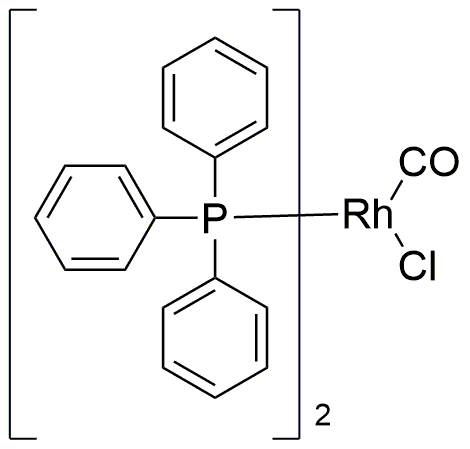Carbonylbis(triphenylphosphine)rhodium(I) chloride is widely utilized in research focused on:
- Catalysis: This compound serves as an effective catalyst in various organic reactions, particularly in the hydrogenation of alkenes and alkynes, enhancing reaction rates and selectivity.
- Organic Synthesis: It plays a crucial role in synthesizing complex organic molecules, making it invaluable in pharmaceutical development and fine chemical production.
- Coordination Chemistry: Researchers use it to study coordination compounds, helping to understand metal-ligand interactions and their implications in catalysis and materials science.
- Environmental Chemistry: The compound is employed in the development of greener chemical processes, reducing the environmental impact of traditional methods by promoting more efficient reactions.
- Material Science: It is used in the fabrication of advanced materials, such as polymers and nanomaterials, due to its unique properties that enhance material performance.
General Information
Properties
Safety and Regulations
Applications
Carbonylbis(triphenylphosphine)rhodium(I) chloride is widely utilized in research focused on:
- Catalysis: This compound serves as an effective catalyst in various organic reactions, particularly in the hydrogenation of alkenes and alkynes, enhancing reaction rates and selectivity.
- Organic Synthesis: It plays a crucial role in synthesizing complex organic molecules, making it invaluable in pharmaceutical development and fine chemical production.
- Coordination Chemistry: Researchers use it to study coordination compounds, helping to understand metal-ligand interactions and their implications in catalysis and materials science.
- Environmental Chemistry: The compound is employed in the development of greener chemical processes, reducing the environmental impact of traditional methods by promoting more efficient reactions.
- Material Science: It is used in the fabrication of advanced materials, such as polymers and nanomaterials, due to its unique properties that enhance material performance.
Documents
Safety Data Sheets (SDS)
The SDS provides comprehensive safety information on handling, storage, and disposal of the product.
Product Specification (PS)
The PS provides a comprehensive breakdown of the product’s properties, including chemical composition, physical state, purity, and storage requirements. It also details acceptable quality ranges and the product's intended applications.
Certificates of Analysis (COA)
Search for Certificates of Analysis (COA) by entering the products Lot Number. Lot and Batch Numbers can be found on a product’s label following the words ‘Lot’ or ‘Batch’.
Numéro de catalogue
Numéro de lot/série
Certificates Of Origin (COO)
This COO confirms the country where the product was manufactured, and also details the materials and components used in it and whether it is derived from natural, synthetic, or other specific sources. This certificate may be required for customs, trade, and regulatory compliance.
Numéro de catalogue
Numéro de lot/série
Safety Data Sheets (SDS)
The SDS provides comprehensive safety information on handling, storage, and disposal of the product.
DownloadProduct Specification (PS)
The PS provides a comprehensive breakdown of the product’s properties, including chemical composition, physical state, purity, and storage requirements. It also details acceptable quality ranges and the product's intended applications.
DownloadCertificates of Analysis (COA)
Search for Certificates of Analysis (COA) by entering the products Lot Number. Lot and Batch Numbers can be found on a product’s label following the words ‘Lot’ or ‘Batch’.
Numéro de catalogue
Numéro de lot/série
Certificates Of Origin (COO)
This COO confirms the country where the product was manufactured, and also details the materials and components used in it and whether it is derived from natural, synthetic, or other specific sources. This certificate may be required for customs, trade, and regulatory compliance.


